Acute
Situated between a disused graveyard and the slaughter houses of Butcher's Row, it was in one of the poorest and most densely populated areas of London. The Hospital's boundaries consisted of Portugal Street on the northwest and Carey Street on the northeast, St Clement's Lane at the southwest, with many houses bordering the southeast side.
Within a year, the Hospital had treated over 1,000 in-patients and over 6,500 out-patients. In the following year the number of out-patients had almost doubled, while the demand for admissions was so great that the Committee of Management, who provided the day-to-day administration and appointed all lay officers, requested that the medical staff "use all their efforts to prevent the necessity of having two or more patients in one bed".
Within three years of its opening, it was evident that extension of the Hospital was imperative. By this time it had 150 beds - some placed in waiting rooms and corridors. However, despite generous donations being received, the subscription rate was low and the Hospital was on the verge of bankruptcy. Despite this, between 1845 and 1851 the freehold of the building and its surrounding land were purchased. An Appeal was launched to raise £15,000 for the building of an extension.
The foundation stone for a new wing was laid on 18th June 1852 by the Archbishop of Canterbury.
The East Wing opened in October 1854. Queen Victoria had given her support, bestowing the Victoria and Albert Wards (the former for men and the latter for women!). However, the campaign continued to raise money to replace the workhouse buildings. As work began on the demolition and rebuilding of the Hospital, in-patients were treated in the new extension.
The new Hospital, built on the site of the old workhouse and the levelled burial ground, opened in 1861. It had cost £100,000 - a huge sum then. The plain 4-storey building contained 200 beds in 14 wards (including a lying-in ward under the direction of Florence Nightingale).
The ground floor contained the Out-Patients Department, a ward, the post-mortem room, a classroom, administration offices and staff accommodation. In the basement were a waiting room for the out-patients, the kitchen and its storerooms, the mortuary and more staff residences. On the upper floors were the remaining wards, a chapel and the operating theatre, which had a tiered gallery that could accommodate 300 students. A vast staircase connected the wards and other parts of the Hospital.
The medical staff included a Consulting Physician, five Physicians, four Assistant Physicians, two Consulting Surgeons, three Surgeons with Assistants and a Surgeon-Dentist. The medical students numbered some 300. A Medical Board was subsequently appointed to oversee their academic work and teaching.
In 1867 the 10-bedded lying-in ward was closed because of the high maternal mortality rate due to puerperal fever.
In 1877 Joseph Lister (1827-1912) performed the first operation under antiseptic conditions - the successful rewiring of a fractured patella (kneecap).
Financial problems continued to dog the Hospital and, in 1884, it almost had to close. The crisis was averted by Mr Matthew Whiting, a merchant who guaranteed the Hospital's overdraft. He also left a bequest in his will and later a ward was named after him.
From 1856 the Sisterhood of St John the Evangelist (better known as St John's House) had provided all nursing care and catering but, in 1885, they were replaced by lay staff, engaged by Miss Monk, the new head of nursing staff. Under the rules then drawn up, she was given the unique title of 'Sister Matron'.
By the 1890s the Hospital was again in severe financial difficulties, with an annual expenditure of £16,300 and a deficit of £5,770. As a means of effecting economy, the management committee proposed building a Nurses' Home on land beside the Hospital, while attempting to make further savings.
By 1894 the Hospital had 220 beds. Its nursing staff consisted of a Sister Matron, a Home Sister, a Night Sister, 8 Ward Sisters, 68 Staff Nurses and probationers, and 8 ward maids.
In 1897 an ophthalmic operating theatre was installed, constructed entirely of glass.
In September 1899 the Hospital closed so that the wards could be refloored and electricity installed throughout. Each of the beds then had a separate lamp. as well as a moveable light (for surgical purposes).
By the turn of the century, following the slum clearances in the late 19th century, the nature of the area around Portugal Street had much altered. A third of the Hospital's patients now came from Brixton, Camberwell, Lambeth and Peckham. South London urgently needed its own large voluntary hospital.
In 1903 some 12 acres of land in Denmark Hill was purchased and presented to the Hospital Governors by the Hon. William Frederick Danvers Smith, of the newsagents and stationers W.H. Smith & Son. A Special Court of the Governors was convened to discuss the proposal to move the Hospital to Denmark Hill. Once agreed, fund-raising for the building of the new Hospital began in earnest.
In 1904 an Act of Parliament was granted to relocate the Hospital to south London.
In 1909 King Edward VII laid the foundation stone for the new King's College Hospital. The firm W.H. Smith paid £1,000 towards the relocation costs, with the promise of another such sum the following year.
The Hospital in Portugal Street closed in July 1913.
Present status (April 2009)
The old Hospital building was then leased by King's College to W.H. Smith & Son, whose owner W.F.D. Smith (the donor of the Denmark Hill land) was chair of the King's College Hospital Trustees - a position once held by his father. (The firm did not buy the freehold until 1954.)
W.H. Smith & Son rebuilt the premises in 1913. The new building opened in 1916 as Strand House - and was immediately requisitioned by the government for use by the Postal Censorship. The firm finally regained possession in 1920. Not long afterwards a rifle range was installed on the roof (the last remnants of which were removed only in 1984).
Strand House was used as offices and a warehouse for W.H. Smith's book trade, but inner-city warehousing had had its day and the firm gave up the building. The heavy floor construction, however, was appropriate for the L.S.E. Library when it opened there in 1978.
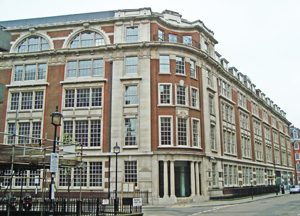
Strand House replaced the Hospital building at the corner of Portugal and Carey Streets. It is now the Lionel Robbins Building at No. 10 Portugal Street and contains the Library and Research Laboratory of the London School of Economics.
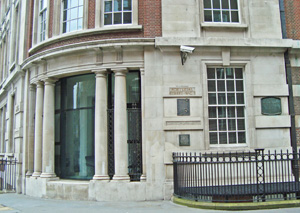
The main entrance on the corner of Portugal and Carey Streets, with various plaques mounted on the wall.
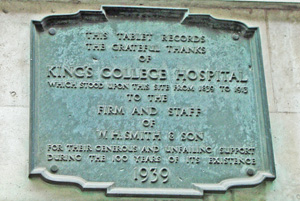
A
plaque of appreciation from King's College Hospital to W.H. Smith &
Son (dated 1939) acknowledging a hundred years of support from the firm.
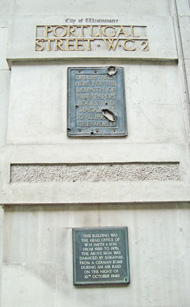
Other plaques commemorate war damage to the building in 1940 (above and below).
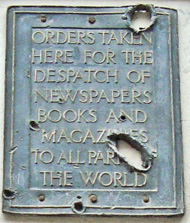
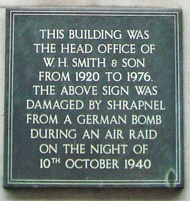
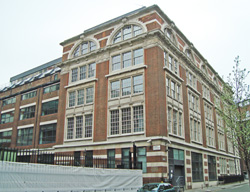
The back of the Lionel Robbins Building on the corner of Grange Court and Carey Street.
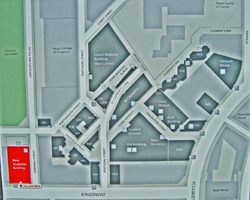
The Hospital site - the trapezoid shape at the top of the image - was bounded on its northwest side by Portugal Street and by Carey Street on the northeast.
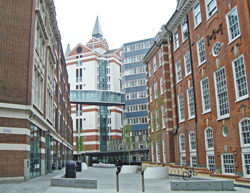
The John Watkins Plaza, built in 2003, with the Lionel Robbins Building on the left and Cowdray House on the right. The Plaza is located in what would have been the centre of the Hospital site.
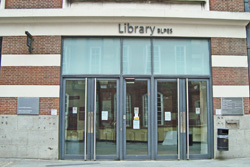
The entrance to the British Library of Economic Science in John Watkins Plaza.
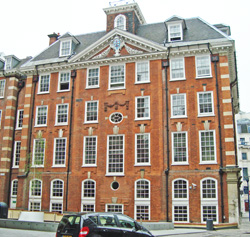
On the other side of the Plaza is the Grade II-listed Cowdray House, built in Wrennaisance style, with an entrance at No. 6 Portugal Street. According to maps of the Hospital era, this was on part of the Hospital site, but this is doubtful.
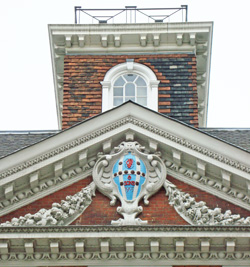
The unattributable coat-of-arms bears the legend "GPJ & Sons 1903".
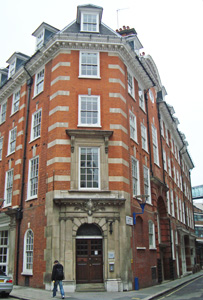
The entrance on the corner of Portugal Street and St Clement's Lane.
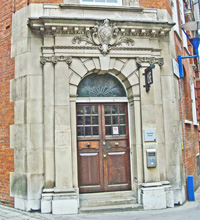
The main door with stone crest above.
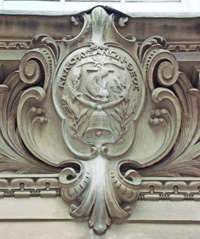
The stone shield depicts an anchor, apparently fouled by a dolphin, above a large bell (the publisher George Bell & Sons had commissioned the building). The Greek inscription - allo agern theos - apparently means God that giveth the increase (1 Corinthians 3.7).
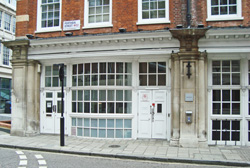
Cowdray House along Portugal Street with large windows at street level.
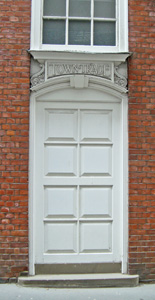
The central doorway of the same building on the St Clement's Lane frontage has the stone inscription 'TOWN TRADE' above.
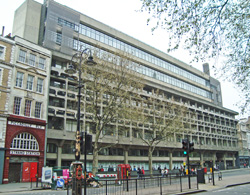
King's College along the Strand has been completely rebuilt. Note the disused Strand station on the left of the image, which is now Grade II-listed.
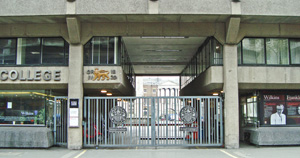
The main gate of the new building is on the line of the original narrow alleyway leading to the main buildings, which can be seen along the entryway.
(Author unstated) 1893 Reflections from a Board Room Mirror. Nursing Record and Hospital World Supplement, 24th August, 27.
(Author unstated) 1894 King's College Hospital. Nursing Record and Hospital World, 6th October, 223.
(Author unstated) 1897 Reflections from a Board Room Mirror. Nursing Record and Hospital World, 13th February, 137.
(Author unstated) 1899 Reflections from a Board Room Mirror. Nursing Record and Hospital World, 23rd September, 256.
(Author unstated) 1903 The Hospital World. British Journal of Nursing, 7th February, 114.
(Author unstated) 1904 Reflections from a Board Room Mirror. British Journal of Nursing, 9th January, 35.
(Author unstated) 1912 Reflections from a Board Room Mirror. British Journal of Nursing, 25th May, 418.
(Author unstated) 1904 "The old hospital and the new". British Journal of Nursing, 19th July, 53.
Burdett HC 1893 Hospitals and Asylums of the World. London, J & A Churchill.
Cartwright FF et al. 1991 The Story of King's College Hospital and its Medical School 1829-1990. London, Farrand Press.
Willoughby Lyle H 1950 An Addendum to King's and Some King's Men. Oxford University Press.
http://archiseek.com
http://denmarkhill.co.uk
http://dulwichonview.org.uk
www.aim25.ac.uk (1)
www.aim25.ac.uk (2)
www.british-history.ac.uk
www.kch.nhs.uk
www.londonremembers.com
www.lse.ac.uk
www.victorianlondon.org
Return to home page